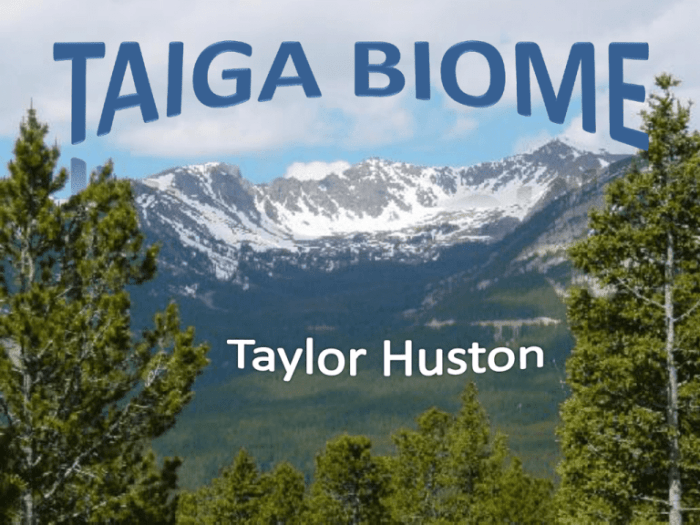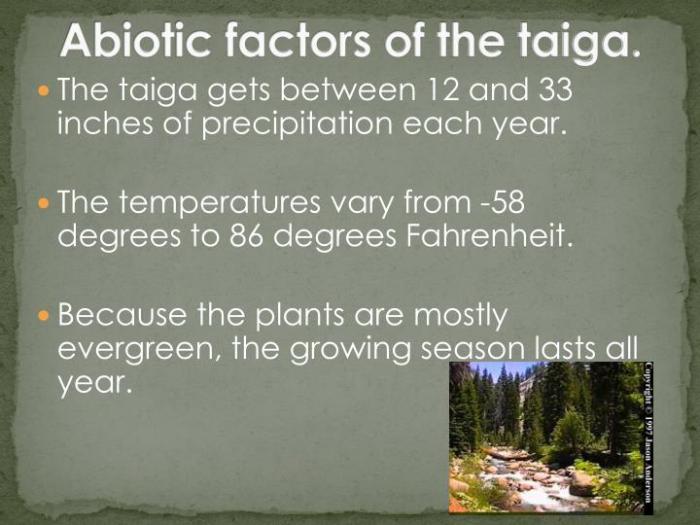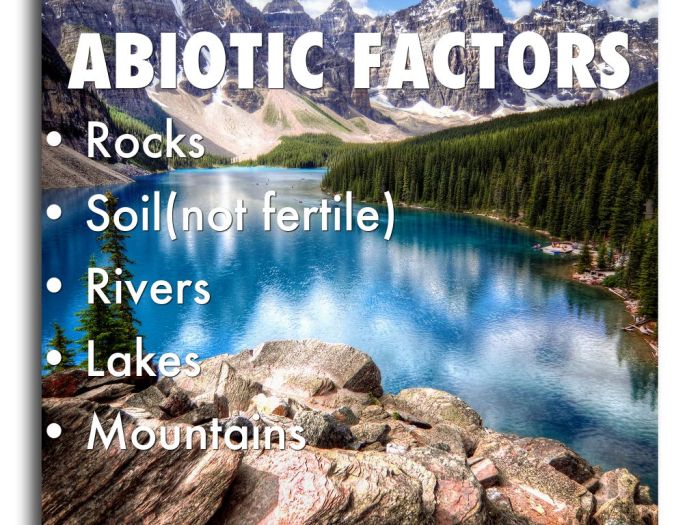The abiotic features of the taiga, a vast and enigmatic biome, paint a vivid portrait of an ecosystem teeming with unique characteristics. From its frigid climate to its diverse geological formations, the taiga’s abiotic components play a pivotal role in shaping its intricate web of life.
Delving into the intricacies of the taiga’s abiotic features, we uncover the secrets behind its resilience and the intricate relationships that sustain this awe-inspiring ecosystem.
Abiotic Components of the Taiga

Abiotic components refer to the non-living elements that shape the environment of an ecosystem. In the taiga, these components include temperature, precipitation, sunlight, soil, and water.
The abiotic components of the taiga interact with each other and with the living organisms to create a unique ecosystem. For example, the cold temperatures and long winters limit the growth of plants, while the short summers provide a burst of growth.
The acidic soil and lack of nutrients also affect the types of plants and animals that can survive in the taiga.
Temperature
The taiga is characterized by cold temperatures. The average temperature in the winter is below freezing, and the average temperature in the summer is only slightly above freezing. The extreme cold can make it difficult for plants and animals to survive.
Precipitation
The taiga receives moderate amounts of precipitation. The precipitation is mostly in the form of snow, but rain can also occur during the summer months. The snowpack can be several feet deep in the winter, and it can take months to melt in the spring.
Sunlight, Abiotic features of the taiga
The taiga receives long hours of sunlight during the summer months. The days are long, and the sun can shine for up to 20 hours a day. However, the days are much shorter in the winter, and the sun may only shine for a few hours a day.
Soil
The soil in the taiga is acidic and nutrient-poor. The acidic soil is caused by the decomposition of organic matter, and the nutrient-poor soil is caused by the cold temperatures and lack of sunlight.
Water
The taiga is home to many lakes, rivers, and streams. The water in these bodies of water is cold and clear. The water is also important for the survival of plants and animals in the taiga.
Climate and Temperature

The taiga’s climate is characterized by long, cold winters and short, warm summers. Precipitation is moderate, falling primarily as snow during the winter months.
Temperature plays a crucial role in shaping the taiga’s ecosystem. The cold winter temperatures limit the growth of trees, resulting in the stunted and conical shape of taiga conifers. Additionally, the cold temperatures slow down decomposition, leading to the accumulation of organic matter in the soil.
Temperature Ranges
The average temperature ranges in different regions of the taiga vary depending on latitude and elevation.
| Region | Average Winter Temperature (°C) | Average Summer Temperature (°C) |
|---|---|---|
| Northern Taiga | -30 to
|
10 to 15 |
| Central Taiga | -20 to
|
15 to 20 |
| Southern Taiga | -10 to 0 | 20 to 25 |
Soil and Topography

The taiga is characterized by thin, acidic soils that are low in nutrients. The soil is often waterlogged due to the cold climate and permafrost, which prevents drainage. The topography of the taiga is generally flat, with some rolling hills and mountains.
Impact of Topography on Vegetation Distribution
The topography of the taiga has a significant impact on vegetation distribution. The higher elevations are typically colder and drier, which supports different plant communities than the lower elevations. For example, the treeline, which marks the boundary between the taiga and the tundra, is found at higher elevations in the taiga.
Soil Characteristics in Different Parts of the Taiga
The soil characteristics in different parts of the taiga vary depending on the climate, topography, and vegetation. The following table compares the soil characteristics in three different parts of the taiga:| Region | Soil Type | pH | Organic Matter | Nitrogen ||—|—|—|—|—|| Northern Taiga | Spodosols | 4.0-5.5
The taiga’s abiotic features, such as its cold temperatures and short growing seasons, shape its unique ecosystem. To learn more about the factors that influence European history, check out the unit 1 ap euro practice test . Returning to the taiga, its abiotic features also affect the distribution of plant and animal life, creating a delicate balance that sustains this vast and unforgiving wilderness.
| 10-20% | 0.1-0.2% || Central Taiga | Inceptisols | 5.5-6.5 | 5-15% | 0.2-0.4% || Southern Taiga | Mollisols | 6.5-7.5 | 2-10% | 0.4-0.6%
|
Water Bodies: Abiotic Features Of The Taiga

The taiga, with its vast expanse, is home to numerous water bodies that play a crucial role in shaping its ecosystem. From meandering rivers to tranquil lakes, these water bodies provide habitat for diverse aquatic life, regulate the region’s climate, and serve as vital transportation routes.
Major Water Bodies
The taiga is renowned for its extensive river systems. The Ob River, flowing through Western Siberia, is one of the longest rivers in the world, stretching over 3,650 kilometers. Other notable rivers include the Yenisei, Lena, and Amur, which traverse vast stretches of the taiga.
In addition to rivers, the taiga also features numerous lakes. Lake Baikal, located in southern Siberia, is the world’s largest freshwater lake by volume, holding approximately 20% of the world’s unfrozen surface freshwater. Other significant lakes include Lake Ladoga and Lake Onega in Russia.
Role in the Taiga Ecosystem
Water bodies in the taiga serve as essential habitats for a wide range of aquatic species. Fish, amphibians, and reptiles thrive in these waters, forming complex food webs that support the region’s biodiversity. The lakes and rivers also provide drinking water for animals and humans alike.
Furthermore, water bodies play a crucial role in regulating the taiga’s climate. They absorb and release heat, influencing local temperatures and humidity. Additionally, water bodies serve as important transportation routes, enabling the movement of people and goods across the vast taiga.
Distribution of Water Bodies
The distribution of water bodies within the taiga varies significantly. The western taiga, particularly in Russia, is characterized by dense river networks and numerous lakes. In contrast, the eastern taiga, such as in Canada and Alaska, has fewer water bodies and a more rugged landscape.
The following map illustrates the distribution of major water bodies within the taiga:
[Insert map of taiga water bodies]
Geological Formations

The taiga’s geological formations are predominantly shaped by the processes of glaciation, erosion, and deposition that occurred during the last glacial period. These processes have carved out distinct geological features that contribute to the taiga’s unique landscape.
The taiga’s geological formations can be broadly categorized into three main types:
Bedrock
The bedrock of the taiga is composed of Precambrian igneous and metamorphic rocks, such as granite, gneiss, and schist. These rocks are often exposed at the surface due to the erosive forces of glaciers and rivers. The bedrock provides a stable foundation for the taiga’s ecosystems and influences the soil composition and drainage patterns.
Glacial Deposits
During the last glacial period, the taiga was covered by massive ice sheets. As the glaciers retreated, they left behind a variety of glacial deposits, including moraines, eskers, and drumlins. Moraines are ridges of unsorted sediment deposited at the edges of glaciers.
Eskers are long, winding ridges of sand and gravel formed by meltwater streams flowing beneath the glaciers. Drumlins are elongated hills with a streamlined shape, formed by the erosive action of glaciers.
Alluvial Deposits
Alluvial deposits are sediments deposited by rivers and streams. These deposits are typically found in floodplains and river valleys. Alluvial deposits consist of sand, silt, and clay and can be highly fertile, supporting a diverse range of plant and animal life.
The geological formations of the taiga have a significant impact on the landscape. The bedrock provides a stable base for the taiga’s ecosystems, while the glacial and alluvial deposits create diverse habitats and influence the soil composition and drainage patterns.
These geological features contribute to the unique character of the taiga and support a wide range of plant and animal life.
Question & Answer Hub
What is the defining characteristic of the taiga climate?
The taiga climate is characterized by long, cold winters and short, cool summers, with average temperatures below freezing for much of the year.
How does topography influence vegetation distribution in the taiga?
Topography plays a significant role in shaping vegetation distribution by affecting factors such as soil moisture, sunlight exposure, and temperature gradients.
What are the major geological formations found in the taiga?
The taiga is characterized by a variety of geological formations, including igneous rocks, metamorphic rocks, and sedimentary rocks, which contribute to the diverse landscapes of the biome.